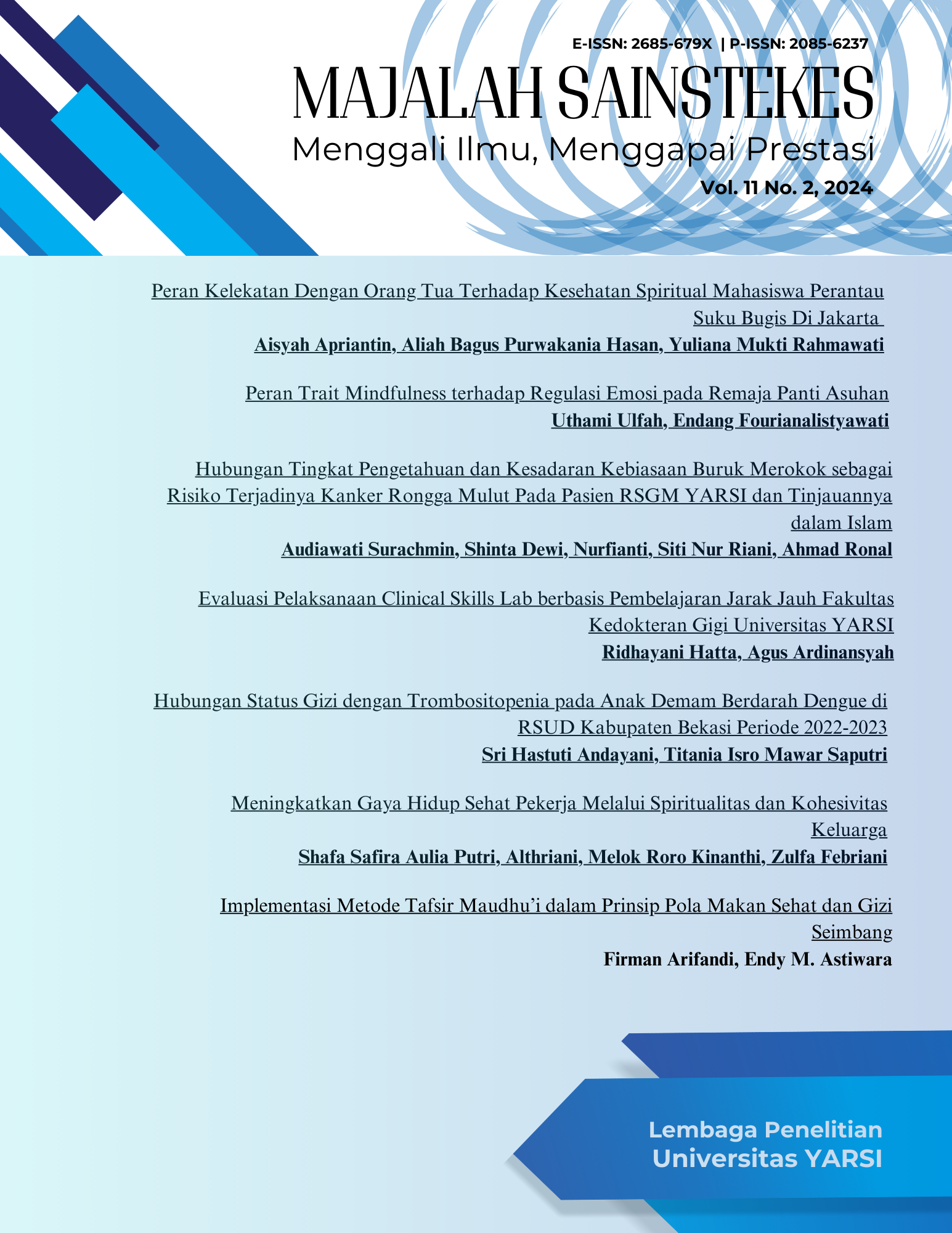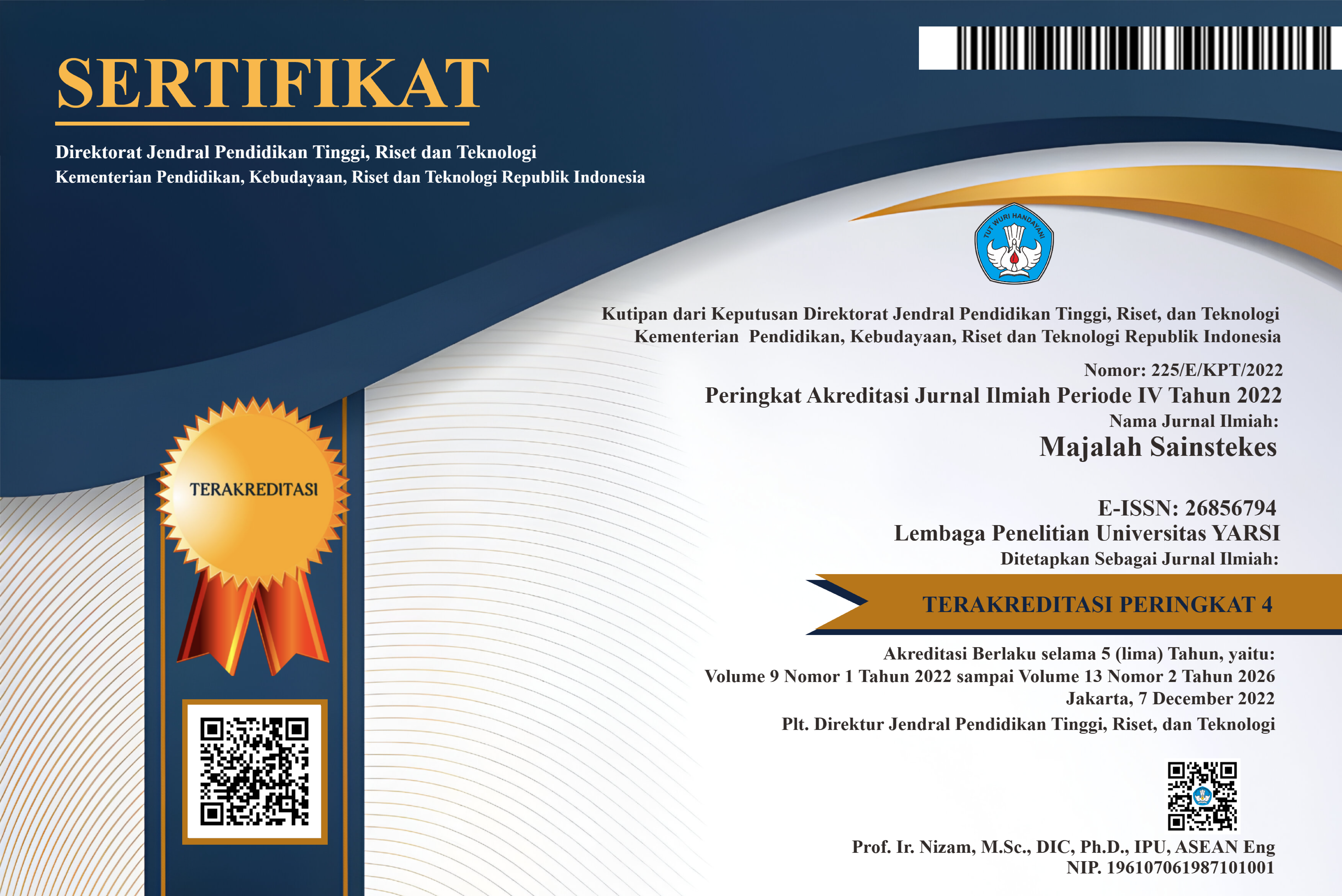Peran Trait Mindfulness terhadap Regulasi Emosi pada Remaja Panti Asuhan
Keywords:
Trait Mindfulness, Regulasi emosi, Remaja Panti AsuhanAbstract
Remaja yang tinggal di panti asuhan mengalami prevalensi permasalahan tinggi terhadap gangguan emosi seperti kepribadian yang inferior, pasif, apatis, menarik diri, mudah putus asa, penuh dengan ketakutan dan kecemasan. Disamping itu, remaja panti asuhan menunjukkan perilaku yang negatif, takut melakukan kontak dengan orang lain, lebih suka sendirian, menunjukkan rasa bermusuhan, lebih egosentrisme. Masalah emosi itu cukup mendominasi dalam hal perkembangan remaja panti asuhan. Oleh karena itu remaja panti asuhan diharapkan mampu meregulasi emosi dalam kehidupannya. Salah satu cara untuk meregulasi emosi dengan baik adalah dengan trait mindfulness. Dalam hal ini tujuan dari penelitian ini adalah untuk mengetahui peran trait mindfulness terhadap regulasi emosi pada remaja Panti Asuhan. Alat ukur pada penelitian ini menggunakan Mindful Attention Awareness Scale (MAAS) untuk mengukur trait mindfulness dan Emotion Regulation Questionnaire (ERQ) untuk mengukur regulasi emosi. Subjek penelitian ini sebanyak 68 remaja yang tinggal di panti asuhan Jabodetabek dengan rentang usia 11-20 tahun. Hasil penelitian ini menunjukkan peran yang signifikan dari trait mindfulness terhadap regulasi emosi cognitive reappraisal (R=0.074 dengan nilai sig. 0.025<0.05). sementara itu tidak terdapat peran yang signifikan dari trait mindfulness terhadap regulasi emosi exppressive suppression (R=0.037 dengan nilai sig. 0.117> 0.05).
References
Aesijah S, Prihartanti N, & Pratisti WD 2016. Pengaruh pelatihan regulasi emosi terhadap kebahagiaan remaja panti asuhan yatim piatu. Jurnal Indigenous, 1(1), 39–47. DOI: https://doi.org/10.23917/indigenous.v1i1.1792
Aqila FY, Prihartanti N, & Asyanti S 2022. Peningkatan penyesuaian diri remaja panti asuhan melalui Pelatihan Regulasi Emosi. Psympathic : Jurnal Ilmiah Psikologi, 8(2), 297–306. https://doi.org/10.15575/psy.v8i2.6681 DOI: https://doi.org/10.15575/psy.v8i2.6681
Arch JJ, & Craske MG 2010. Laboratory stressors in clinically anxious and non-anxious individuals: The moderating role of mindfulness. Behaviour Research and Therapy, 48(6), 495–505. https://doi.org/10.1016/j.brat.2010.02.005 DOI: https://doi.org/10.1016/j.brat.2010.02.005
Azwar S 2022. Reliabilitas dan validitas: Edisi 4. Pustaka Pelajar.
Bränström R, Duncan LG, & Moskowitz JT 2011. The association between dispositional mindfulness, psychological well-being, and perceived health in a Swedish population-based sample. British Journal of Health Psychology, 16(2), 300–316. https://doi.org/10.1348/135910710X501683 DOI: https://doi.org/10.1348/135910710X501683
Brown KW, & Ryan RM 2003. The benefits of being present: Mindfulness and its role in psychological well-being. Journal of Personality and Social Psychology, 84(4), 822–848. https://doi.org/10.1037/0022-3514.84.4.822 DOI: https://doi.org/10.1037/0022-3514.84.4.822
Chambers R, Gullone E, & Allen NB 2009. Mindful emotion regulation: An integrative review. Clinical Psychology Review, 29(6), 560–572. https://doi.org/10.1016/j.cpr.2009.06.005 DOI: https://doi.org/10.1016/j.cpr.2009.06.005
Chiesa A, & Serretti A 2009. Mindfulness-based stress reduction for stress management in healthy people: a review and meta-analysis. The Journal of Alternative and Complementary Medicine, 15(5), 593–600. DOI: https://doi.org/10.1089/acm.2008.0495
Dalimunthe KL 2009. Kajian mengenai kondisi psikososial anak yang dibesarkan di panti asuhan. In Universitas Padjadjaran, Jawa Barat. Universitas Padjadjaran, Jawa Barat.
Diener E, Lucas RE, & Oishi S 2002. Subjective well-being: The science of happiness and life satisfaction. In Handbook of positive psychology (Vol. 2, pp. 63–73). DOI: https://doi.org/10.1093/oso/9780195135336.003.0005
Dubert CJ, Schumacher AM, Locker L, Gutierrez AP, & Barnes VA 2016. Mindfulness and emotion regulation among nursing students: Investigating the mediation effect of working memory capacity. Mindfulness, 7, 1061–1070. DOI: https://doi.org/10.1007/s12671-016-0544-6
Eddy V 2013. Perubahan Regulasi Emosi Para Meditator Mindfulness [Skripsi]. Universitas Sanata Dharma.
Gómez-Ortiz O, Romera EM, Ortega-Ruiz R, Cabello R, & Fernández-Berrocal P 2016. Analysis of emotion regulation in spanish adolescents: Validation of the emotion regulation questionnaire. Frontiers in Psychology, 6(JAN). https://doi.org/10.3389/fpsyg.2015.01959 DOI: https://doi.org/10.3389/fpsyg.2015.01959
Greenberg MT, & Armsden, G 2009. Inventory of parent and peer attachment (IPPA). Prevention Research Center.
Gross JJ 2002. Emotion regulation: Affective, cognitive, and social consequences. DOI: https://doi.org/10.1017/S0048577201393198
Gross JJ, & John OP 2003. Individual differences in two emotion regulation processes: Implications for affect, relationships, and well-being. Journal of Personality and Social Psychology, 85(2), 348–362. https://doi.org/10.1037/0022-3514.85.2.348 DOI: https://doi.org/10.1037/0022-3514.85.2.348
Gross JJ, & Thompson RA 2007. Emotion regulation: Conceptual foundations. In J. J. Gross (Ed.), Handbook of emotion regulation (pp. 3–24). Guilford Press.
Guendelman S, Medeiros S, & Rampes H 2017. Mindfulness and emotion regulation: Insights from neurobiological, psychological, and clinical studies. Frontiers in Psychology, 8(MAR). https://doi.org/10.3389/fpsyg.2017.00220 DOI: https://doi.org/10.3389/fpsyg.2017.00220
Gullone E, & Taffe J 2012. The emotion regulation questionnaire for children and adolescents (ERQ-CA): A psychometric evaluation. Psychological Assessment, 24(2), 409–417. https://doi.org/10.1037/a0025777 DOI: https://doi.org/10.1037/a0025777
Hartini N 2001. Deskripsi kebutuhan psikologi pada anak panti asuhan. Insan Media Psikologi, 3(2), 109–118.
Helgeson VS 2020. The psychology of gender. Routledge. DOI: https://doi.org/10.4324/9781003016014
Hidayat O, & Fourianalistyawati E 2017. Peranan mindfulness terhadap stres akademis pada mahasiswa tahun pertama. Psikogenesis, 5(1). DOI: https://doi.org/10.24854/jps.v5i1.494
Hill CLM, & Updegraff JA 2012. Mindfulness and its relationship to emotional regulation. Emotion, 12(1), 81–90. https://doi.org/10.1037/a0026355 DOI: https://doi.org/10.1037/a0026355
Hurlock EB 1997. Psikologi perkembangan: Suatu pendekatan sepanjang rentang kehidupan. Erlangga.
Kabat-Zinn J 2013. Full catastrophe living: Using the wisdom of your body and mind to face stress, pain, and illness (Second Edition). Unified Buddhist Church, Inc.
Khoury B, Lecomte T, Fortin G, Masse M, Therien P, Bouchard V, Chapleau MA, Paquin K, & Hofmann SG 2013. Mindfulness-based therapy: A comprehensive meta-analysis. Clinical Psychology Review, 33(6), 763–771. https://doi.org/10.1016/j.cpr.2013.05.005 DOI: https://doi.org/10.1016/j.cpr.2013.05.005
Mandal SP, Arya YK, & Pandey R 2014. Understanding emotion regulatory effect of mindfulness: Role of differentiation and range of emotional experiences. Indian Journal of Positive Psychology, 5(4), 356–362. https://www.researchgate.net/publication/274373746
McMain S, Korman LM, & Dimeff L 2001. Dialectical behavior therapy and the treatment of emotion dysregulation. Journal of Clinical Psychology, 57(2), 183–196. DOI: https://doi.org/10.1002/1097-4679(200102)57:2<183::AID-JCLP5>3.0.CO;2-Y
Neff KD, & Costigan AP 2014. Self-compassion, wellbeing, and happiness. Psychologie in Österreich, 2(3), 114–119.
Nolen-Hoeksema S 2012. Emotion regulation and psychopathology: The role of gender. Annual Review of Clinical Psychology, 8, 161–187. https://doi.org/10.1146/annurev-clinpsy-032511-143109 DOI: https://doi.org/10.1146/annurev-clinpsy-032511-143109
Nurmalita R, & Hidayati F 2014. Hubungan antara regulasi emosi dengan kompetensi interpersonal pada remaja panti asuhan. Jurnal Empati, 3(4), 512–520. DOI: https://doi.org/10.14710/empati.2014.7613
Ochsner KN, & Gross JJ 2008. Cognitive emotion regulation: Insights from social cognitive and affective neuroscience. Current Directions in Psychological Science, 17(2), 153–158. https://doi.org/10.1111/j.1467-8721.2008.00566.x DOI: https://doi.org/10.1111/j.1467-8721.2008.00566.x
Oktaviani MA, & Notobroto HB 2014. Perbandingan tingkat konsistensi normalitas distribusi metode kolmogorov-smirnov, lilliefors, shapiro-wilk, dan skewness-kurtosis. Jurnal Biometrika Dan Kependudukan , 3(2), 127–135.
Papalia DE, Olds SW, & Feldman RD 2007. Human development. McGraw-Hill.
Piet J, & Hougaard E 2011) The effect of mindfulness-based cognitive therapy for prevention of relapse in recurrent major depressive disorder: A systematic review and meta-analysis. Clinical Psychology Review, 31(6), 1032–1040. https://doi.org/10.1016/j.cpr.2011.05.002 DOI: https://doi.org/10.1016/j.cpr.2011.05.002
Prayitno P 2012. Jenis Layanan dan Kegiatan Pendukung Konseling. Padang: Universitas Negeri Padang.
Rembulan CL 2009. Penguatan resiliensi dengan pelatihan strategi koping fokus emosi pada remaja putri yang tinggal di panti asuhan [Thesis]. Universitas Gadjah Mada.
Santrock JW 2011a. Life-span Development. McGraw-Hill.https://books.google.co.id/books?id=LLfgQQAACAAJ
Santrock JW 2011b. Life-span development. McGraw-Hill. https://books.google.co.id/books?id=LLfgQQAACAAJ
Sarwono WS 2012. Psikologi remaja: Definisi remaja. In Jakarta: Rajagrafindo Persada.
Setiawan AP 2016. Hubungan Konsep Diri Dengan Penyesuaian Diri Remaja Panti Asuhan [Skripsi]. Universitas Bhayangkara.
Shaffer KA 2005. On the nature and function of emotion: A component process approach. In K. R. Scherer & P.E. Ekman (Eds.), Approaches to emotion (pp. 293–317). Erlbaum.
Singh NN, Wahler RG, Adkins AD, Myers RE, Winton ASW, Strand PS, Hill OW, Singh J, Barber JW, Sabaawi M, & Dumas J 2003. Soles of the feet: A mindfulness-based self-control intervention for aggression by an individual with mild mental retardation and mental illness. Research in Developmental Disabilities, 24(3), 158–169. https://doi.org/10.1016/S0891-4222(03)00026-X DOI: https://doi.org/10.1016/S0891-4222(03)00026-X
Southam-Gerow MA, & Kendall PC 2002. Emotion regulation and understanding Implications for child psychopathology and therapy. Clinical Psychology Review, 22(2), 189–222. DOI: https://doi.org/10.1016/S0272-7358(01)00087-3
Sugiyono D 2013. Metode penelitian pendidikan pendekatan kuantitatif, kualitatif dan R&D.
Tugade MM, & Fredrickson BL 2007. Regulation of positive emotions: Emotion regulation strategies that promote resilience. Journal of Happiness Studies, 8(3), 311–333. https://doi.org/10.1007/s10902-006-9015-4 DOI: https://doi.org/10.1007/s10902-006-9015-4
Westermann N, Busching R, Klein AM, & Warschburger P 2024. The longitudinal interplay between adverse peer experiences and self-regulation facets: A prospective analysis during middle childhood. Research on Child and Adolescent Psychopathology, 52(2), 293–308. https://doi.org/10.1007/s10802-023-01117-1 DOI: https://doi.org/10.1007/s10802-023-01117-1
Wilson JW 1999. Emotion Related Regulation: An Emerging Construct. Developmental Psychology, 35(1), 214–222. DOI: https://doi.org/10.1037//0012-1649.35.1.214
Woodward SH, Shurick AA, Alvarez J, Kuo J, Nonyieva Y, Blechert J, McRAE K, & Gross JJ 2015. A psychophysiological investigation of emotion regulation in chronic severe posttraumatic stress disorder. Psychophysiology, 52(5), 667–678. DOI: https://doi.org/10.1111/psyp.12392
Yusuf S 2012. Psikologi perkembangan anak dan remaja. Remaja Rosdakarya.
Zulkifli 2009. Remaja Rosdakarya. PT. Remaja Rosdakary.
Downloads
Published
How to Cite
Issue
Section
License
Copyright (c) 2025 Uthami Ulfah, Endang Fourianalistyawati

This work is licensed under a Creative Commons Attribution-NonCommercial 4.0 International License.

 Uthami Ulfah
Uthami Ulfah
 Universitas YARSI
Universitas YARSI













